The multifamily sector remains a top asset class in commercial real estate and continues to benefit from strong demand drivers. Despite stabilizing rent growth from record highs, multifamily fundamentals are still favorable relative to other asset classes. Newly released data indicating a Q1’23 drop in multifamily investment demonstrates that this sector is not immune to the impact of rising capital costs, bank failures, and growing recession fears on the broader commercial real estate industry.
- Despite a decline in multifamily investment last year, 2022 was still the second largest total on record. Last quarter’s 74% drop in transaction volume vs. Q1’22 reflects the impact of banking unrest, higher interest rates and moderating rent growth.
- Half a million new units expected to be delivered this year represent a 40-year high, which could adversely impact a rebound in investment.
- Investors looking for multifamily investment opportunities could see an increase in forced sales from owners with floating-rate debt coming due this year.
The multifamily sector is clearly adjusting to new market dynamics that have taken root since the record-setting transactions of 2021. Investors are being more cautious and selective as apartment trades have slowed considerably, a byproduct of downward pressure on rents, income, and values in an uncertain economic climate, according to a LightBox report, Early 2023 Barometers: Resetting Market Expectations.
Prices for multifamily declined by 8.7% in February according to MSCI, compared to February 2022. Green Street’s research into publicly traded landlords revealed an even more pronounced 20% drop in multifamily properties compared to the sector’s late 2021 peak. Two scenarios could accelerate activity levels: forced sales as assets return to lenders who will be motivated to get them off their books; and continued downward movement of the 10-year U.S. Treasury yield, which will push cap rates lower and increase investment activity.
According to CBRE Research, multifamily investment volume in 2022 decreased by 19% year-over-year to $278.8 billion, but was the second largest annual total on record. Fourth quarter 2022 volume fell by 34% quarter-over-quarter and 70% year-over-year to $48 billion. Just-released first quarter data show that the Q4 trend continued with a 74% decline over Q1’22 to sales of just $14 billion—the slowest quarter since 2012 (with the exception of the Q2’20 COVID freeze).
The strength of multifamily markets varies considerably across the US. The top five areas for multifamily investment are Los Angeles-Long Beach-Anaheim (California), New York-Newark-Jersey City (New York and New Jersey), Dallas-Fort Worth-Arlington (Texas), San Diego-Chula Vista-Carlsbad (California), and Miami-Fort Lauderdale-Pompano Beach (Florida).
Rent growth in the Mid-Atlantic metro markets surveyed by Newmark remained positive in the fourth quarter of 2022, but the pace of growth has decreased due to slowing demand. Among the three substate regions in the Washington, D.C. metro area, Northern Virginia and suburban Maryland have the highest annualized rent appreciations at 5.9% and 5.5% respectively. That region recorded a healthy $2.1 billion in sales in the fourth quarter, less than half of the $4.5 billion recorded during the fourth quarter of 2021, when capital markets activity was at robust levels throughout the industry. One notable factor that works in multifamily’s favor, according to Christine Espenshade, Vice Chairman, at Newmark’s Multifamily Capital Markets division, is that “it is the one asset class where debt is readily available, and it’s more easily priced through Fannie/Freddie.”
Other factors having an impact on multifamily activity are the slowing of new construction starts and multifamily rental development. With mortgage rates near 7%, homebuilders have reduced the number of new home starts due to capital costs. Developers have reduced them because banks are requiring higher interest rates on construction loans and are providing lower proceeds because of concerns about a housing correction and recession in 2023.
A review of LightBox RCM® data since 2019 shows multifamily among the top asset classes due to the volume of activity, the high level of project value, and other factors. The data indicates the number of multifamily projects increased by 43% from 2019 to 2022.
The average number of NDAs executed (a key measure of demand) in 2022 across all asset types was nearly 80 per listing. However, it was much higher (nearly 110 NDAs) for multifamily.
Negative rent growth is expected in most U.S. markets, with some falling by as much as 6%, according to a recent report by Origin Investments, a fund manager focused on the multifamily sector. Most other industry firms believe the pace of growth has slowed into the single digits, yet they still predict positive rent growth for 2023.
Origin’s prediction is based on extensive datapoints, including record levels of new inventory coming online in 2023 and the increasing percentage of income renters are paying in rent. Renters in some markets, such as New York and Miami, are spending more than one-third of their income on rent, while industry guidelines have been closer to 25%.
Origin warns that a healthier long-term outlook won’t mean much to owners who paid inflated prices for assets and/or didn’t manage their debt. Given the prevalence of those scenarios, the firm predicts the number of owners facing distress will increase as 2023 unfolds and throughout 2024—though the long-term outlook for the sector remains healthy despite weaker yields, particularly when viewed against weaker sectors like office and retail. “The underlying fundamentals in multifamily remain incredibly compelling over the long-term,” noted Espenshade, “We are going through a repricing exercise now, Debt is readily available just with different prices and different terms but multifamily is definitely one of the best places in commercial real estate.”
Market conditions are a mixed bag as the second quarter gets underway. Interest rate hikes are moderating, but there are growing concerns of more bank failures ahead. Some buyers are waiting for more clarity on a property pricing reset and the market is bracing for distress in certain asset classes and metros. There is no shortage of metrics to watch as the next few quarters unfold.
Read the full LightBox report here. Watch LinkedIn Live recording here.
